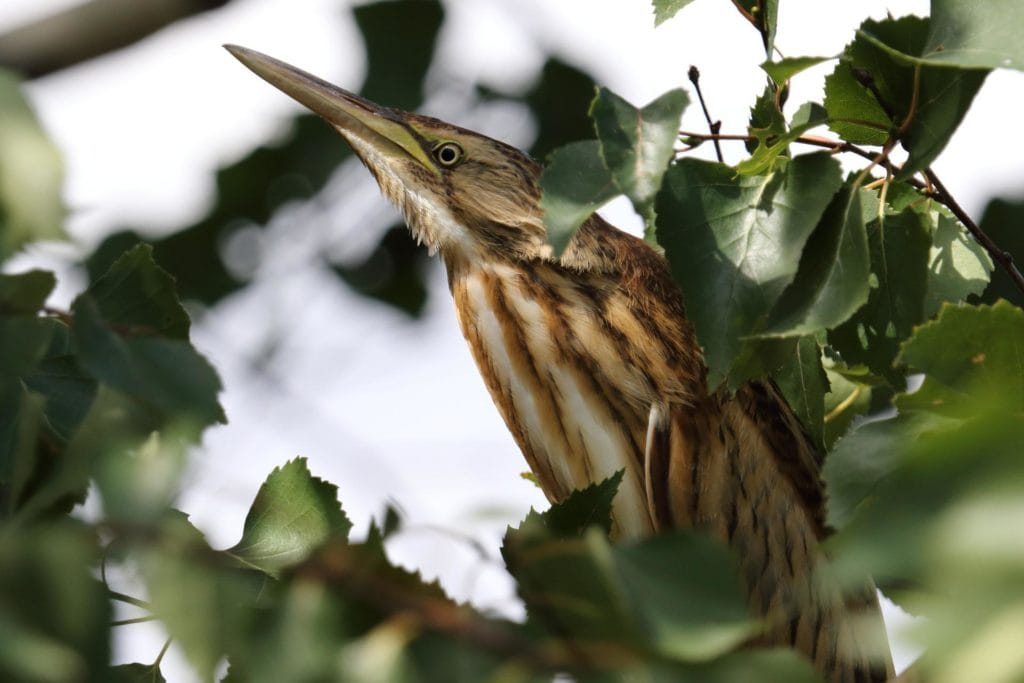With nicknames like “water-belcher,” “stake-driver,” and “thunder-pumper,” you might picture something resembling an ancient Norse deity or a beastly monster from a forgotten fairytale. While the Bittern is certainly neither of these things, I would hesitate to say that it would disappoint your expectations. Known for its sounds which are often referred to as “booming,”
“clucking,” or “bellowing,” the Bittern is an unusual member of the heron family whose appearance often seems to match the famously perplexing sounds which it creates. Elusive and more often heard than seen, when spotted Bitterns are often found in an unusual rigid pose with neck outstretched and head pointed to the sky. This is done to make use of the Bittern’s impressive camouflage which allows it to disappear into the marshes. Because of the unique way in which the Bittern’s eyes focus, these birds also commonly adopt a goofy cross-eyed expression. (1)
Although the Bittern may not be quite the beast one might expect based on its voice, this heron species is much beloved by birders around the world. Furthermore, the Bittern has earned a special place in the folklore of many cultures because its cry has often inspired spine-tingling tales of monsters lurking in swamps and marshes.
Bittern Symbolism and Meaning
Bitterns are best known for their noise. The Bittern symbolizes the importance of raising your voice and speaking your mind even when the result may not be beautiful or polished. The Bittern is a small bird which dares to command huge stretches of marshland by projecting its voice out across the land.
Bitterns are known to stand quite still when spotted. They stretch their necks towards the sky with their bills facing straight up. This posture helps them to blend into the reeds which make up their habitat. The Bittern can thus represent ingenuity, spirituality, or patience. This bird’s clever adaptation allows it to stay alive by gazing at the heavens. (2)
A Bittern may also symbolize fluidity, acuity, silliness, focus, or surprises.
Bittern Native American Symbolism
In Native American symbolism, Bitterns are very closely connected with water and rainfall. These birds might also be thought of as representing the sun because of the posture they sometimes assume. The name for Bitterns in various languages means “sun gazer.” (3)
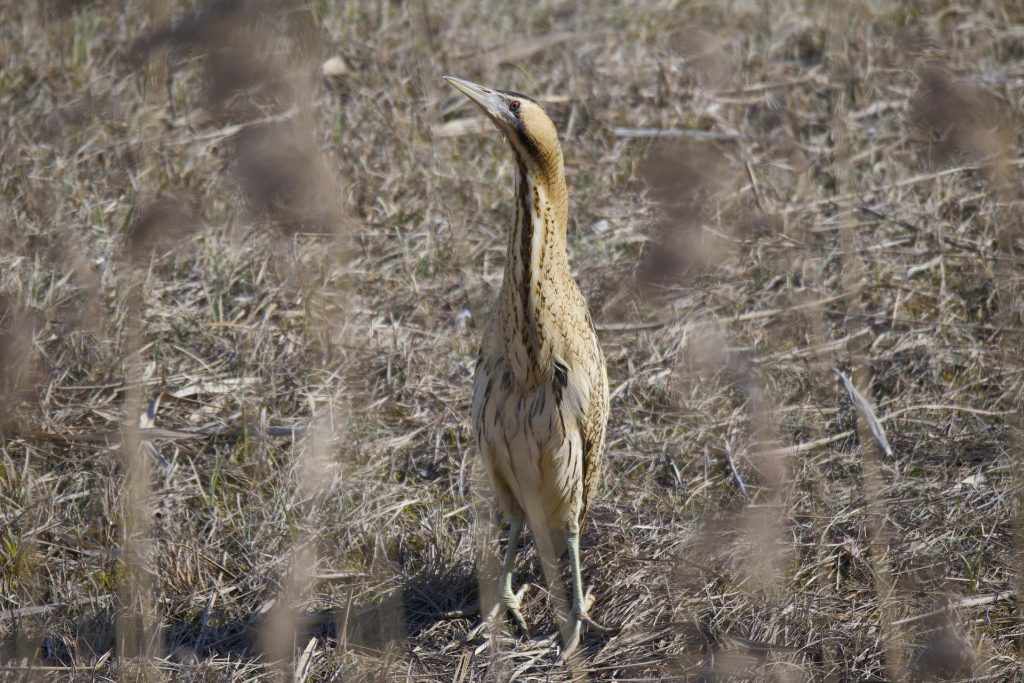
Bittern Christianity Symbolism
In the Bible, the Bittern is connected with the untamed wilderness as well as the concepts of destruction and desolation. Isaiah 14:22-23 describes the destruction of Babylon as such:
“For I will rise up against them, saith the LORD of hosts, and cut off from Babylon the name, and remnant, and son, and nephew, saith the LORD.
— Isaiah 14:22-23 (4)
I will also make it a possession for the bittern, and pools of water: and I will sweep it with the besom of destruction, saith the LORD of hosts.”
The King James version of the Bible uses the word “Bittern” while other versions translate this passage with “owl,” “osprey,” or even “hedgehog” instead. Whether Bittern is truly the most accurate translation or not, the presence of this animal in Babylon is meant to demonstrate that the city has been reclaimed by nature and is inhabited by wild beasts rather than people. (5)
Bittern Celtic Symbolism
In most Celtic symbolism, birds are representative of various concepts including the otherworldly realm of the supernatural. The Celtic Otherworld is a place of transitions and liminal spaces which is often connected with water as well. The Bittern easily embodies these traits and could be understood as a guardian of the transition between worlds. This is amplified by the unusual appearance of the Bittern and the famously eerie sounds that this bird is known to make. In many Celtic stories, water birds are the forms taken by shapeshifting women. (6)
Bittern in Dreams
Dreaming of the elusive Bittern may indicate that there is an issue lurking just beneath the surface of your thoughts which you need to address. The Bittern can be heard and felt even in places where it hasn’t yet been seen.
Bittern dreams can also act as a reminder to consider the most likely explanation for your situation. When you hear a frightening noise, it is easy to assume that a monster is nearby. In some cases, though, the things that alarm us are actually simple and harmless. The monster you’re afraid of may turn out to be nothing at all.
Bittern Encounters and Omens
Encountering a Bittern is a reminder not to fear the unknown. What seems alien and frightening might actually be somethin familiar or comforting viewed through the lens of anxiety. The Bittern reminds you to plunge into new situations with courage and optimism. Remember that when in danger the Bittern looks to the sky. Your core beliefs will bring you courage and help you to face whatever threats appear.
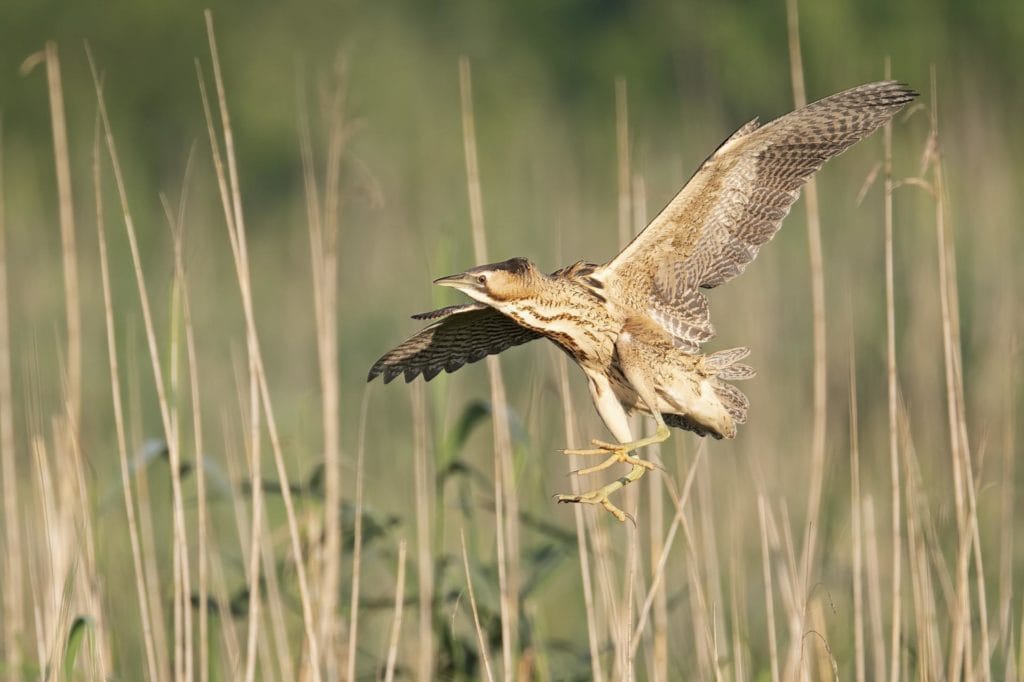
Bittern in Mythology & Folklore
Bitterns are present in folklore from around the world for a number of reasons and in a number of roles. In many cases, the distinctive cry of the Bittern is the primary cause for its place in mythology. This cry has been associated with anything from magical beasts, to haunting spirits, to cryptids. In The Hound of Baskervilles, it is suggested that the strange sounds on the moor which the locals have attributed to the the fearsome Hound might actually be the booming call of a Bittern:
“A long, low moan, indescribably sad, swept over the moor. It filled the whole air, and yet it was impossible to say whence it came. From a dull murmur it swelled into a deep roar, and then sank back into a melancholy, throbbing murmur once again. Stapleton looked at me with a curious expression in his face….
“Bogs make queer noises sometimes. It’s the mud settling, or the water rising, or something.”
“No, no, that was a living voice.”
“Well, perhaps it was. Did you ever hear a bittern booming?”
“No, I never did.”
“It’s a very rare bird—practically extinct—in England now, but all things are possible upon the moor. Yes, I should not be surprised to learn that what we have heard is the cry of the last of the bitterns.””
— The Hound of Baskervilles by Sir Arthur Conan Doyle (7)
In the folklore of the United States, it has been believed, at times, that Bitterns have a bizarre and inexplicable ability to emit light. This is not true, obviously, but claims of Bitterns with beams of light in their chests have floated around the U.S. since at least the nineteenth century. Take, for example, this quote from an 1836 educational book for girls entitled The Young Ladies’ Book:
“It is called by Wilson the great American bittern, but, what is very extraordinary, he omits to mention that it has the power of emitting a light from its breast, equal to the light of a common torch, which illuminates the water so as to enable it to discover its prey…. I took some trouble to ascertain the truth of this, which has been confirmed to me by several gentle-men of undoubted veracity, and especially by Mr. Franklin Peale, the proprietor of the Philadelphia Museum.”
— The Young Ladies’ Book (1836) (8)
Native American Mythology:
In the mythology and folklore of Native American groups, the Bittern is firmly connected with water. The iconic neck-outstretched posture of the Bittern is sometimes used as a Native American symbol for water. This posture is also a likely candidate for the origin of the common Native American name for the Bittern. In many different Native languages, Bitterns are called “sun gazer” or “one who looks up at the sun.” (9)
Athabaskan flood myths include versions where the Bittern is responsible for saving the world from a catastrophic flood. In these stories, the Bittern gulps up all of the flood waters and spits them out in long flowing streams which become the earth’s rivers. (10)
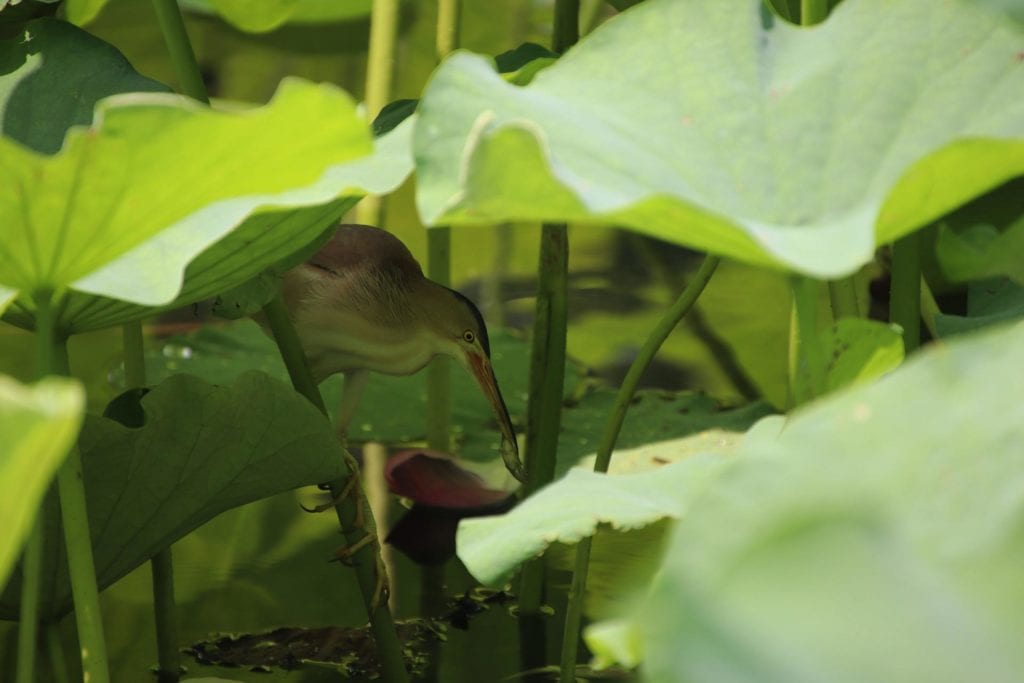
Slavic Mythology:
In Slavic mythology, there is a monster known as “Drekavac” which means “the screamer.” This creature is said to be a twisted monster born from the undead souls of sinful men. The appearance of the Drekavac is said to foretell death and disaster. Much like Arthur Conan Doyle’s proposition that the booming Bittern could be mistaken for a murderous ghostly hound, the popular short story, Brave Mita and the Drekavac From the Pond, features a young boy who tries to help his village by capturing the Drekavac whose frightful cries have scared all of the fishermen away from the pond. When Mita captures the source of the cries, he finds a Eurasian Bittern rather than the monster that he was expecting. (11)
Egyptian Mythology:
Egyptian mythology attributes special roles to the marsh birds which dwell along the banks of the Nile. In Egyptian myth, the human soul is divided into multiple parts, several of which are represented by marsh birds. The Ibis is especially important and is the emblem of Thoth, the god of knowledge. Bitterns are not specified as particularly important amongst the marsh birds of the Nile, however they do appear in some of the tomb art which has been uncovered in the tombs of pharaohs. Furthermore, as Nile birds these birds can be convincingly connected to the spiritual realm and the kingdom of the dead. (12)
European Mythology:
Nixie, Nakk, and Nokk are just some of the names given to the mythological water spirits which are found in Germanic and Scandinavian folklore traditions. These creatures are usually described as shapeshifting spirits which inhabit water and often foretell or cause drowning incidents. In some traditions, the Nixie are benevolent spirits who produce enchanting music and are willing to teach their songs to humans. In others, they are otherworldly monsters capable of destruction. Often Nixies take the form of horses, much like the Scottish Kelpie. In any case, these mysterious supernatural entities are sometimes connected with Bitterns. The nickname “Bull o’ the Bog” exemplifies the role of the Bittern as a haunting voice heard within the marshes. (13) (14)
The “Bull o’ the Bog” nickname is sometimes used in connection with the “Boobrie.” This Scottish cryptid is said to be a fearsome shapeshifting bird which preys upon cattle and issues a haunting cry. While many believe that this creature is based on sightings of the now-extinct Great Auk, the unusual sounds and appearance of the Bittern has made this bird a possible candidate as well. (15)
One particular strange piece of Medieval heraldry from Medieval European bestiary manuscripts depicts a monster referred to as an “Ass-Bittern.” This bizarre hybrid is exactly what it sounds like: a freakish amalgam comprised of a donkey or “ass” and a Bittern. (16)
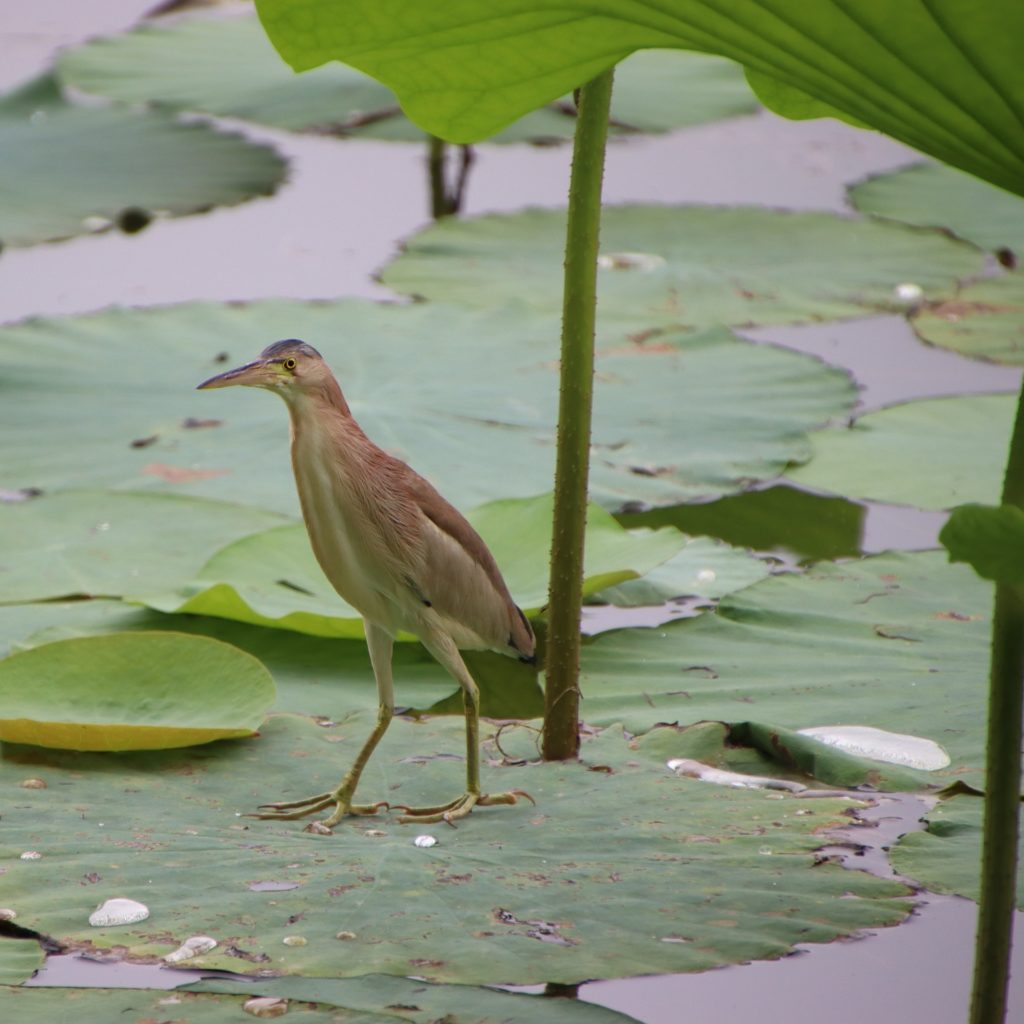
Bittern Spirit Animal
If the Bittern is your spirit animal then you’re a one-of-a-kind soul who is shy and secretive while also being bold and expressive at the same time. These may seem like contradictions, but the Bittern embodies both traits.
People with the Bittern spirit animal often prefer to blend in with the background and don’t enjoy attention. If they feel too ignored or neglected, though, Bittern spirits will raise their voices and speak their minds. Because they are so shy but so interested in self expression, Bittern spirits are often creative types.
Bittern Totem Animal
People with the Bittern totem animal have a special talent for keeping secrets. Used to hiding and prone to enjoying privacy, the Bittern totem animal holds on to secrets at almost any cost. They are the favorite confidant of their friends because they will take a friend’s secret to their grave. This makes them especially trustworthy. If a Bittern totem shares its own secret with a friend, they must trust their friend completely. Betrayal is unacceptable to those with the Bittern totem.
Bittern Power Animal
The power of the Bittern is influence. People with the Bittern power animal have a special talent for affecting others. The voice of the Bittern often strikes fear into people’s hearts, yet this bird’s silly expression is also a source of laughter. Individuals with this power animal must be careful not to manipulate others and must only put their talent to use in benevolent ways.
Bittern Tattoo Meaning
A Bittern tattoo may represent anything for spirituality to humor. In some cases, a Bittern tattoo may stand for the need to conquer one’s fears. Like the Bittern, most of the things that scare us are not as bad as they seem.
Conclusion
Who would have thought that one little heron could inspire so many mysteries and monsters. The Bittern is the ultimate Scooby Doo villain, by no fault of its own of course. Beneath the masks of many cryptic beasts lies a beautiful wading bird whose voice commands respect! That voice, along with the Bittern’s many other fascinating qualities, has inspired humankind for centuries.

